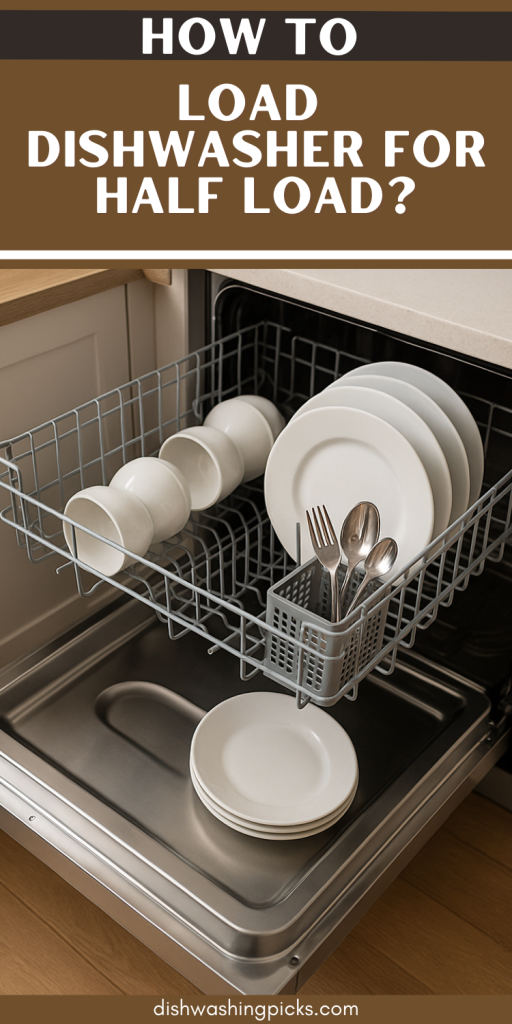
Okay, picture this: it’s midweek, and you’ve got just enough dirty dishes to annoy you, but not quite enough to justify a full dishwasher cycle. You think, “Should I just run it anyway? Or wait another day and deal with Mount Dishmore on the counter?” Sound familiar?
Good news—you don’t have to choose between chaos and waste. Let’s talk about how to properly (and efficiently) load your dishwasher for a half load without feeling guilty about it.
Step 1: Know Your Dishwasher’s Half-Load Setting
First up—check your dishwasher’s manual or control panel. Some modern dishwashers have a half-load or zone wash option. This tells the dishwasher to only use one spray arm (typically top or bottom), saving water and energy.
Pro tip: If yours lets you pick which rack to wash, use that to your advantage depending on what needs cleaning—glasses up top, pans on the bottom.
If your dishwasher doesn’t have a dedicated setting? No worries. You can still run a half load, just more strategically.
Step 2: Keep It Balanced (No Tetris Champs Needed)
You don’t need to go full-on geometry wizard here, but loading evenly matters. Spread dishes out across the selected rack instead of bunching them all together.
Why? Because even spacing = better water coverage = cleaner dishes. Simple math.
Step 3: Skip the Overkill
When running a half load, you don’t need to douse your dishes in soap like you’re fighting grease demons. Use a bit less detergent than usual, especially if your dishwasher doesn’t auto-adjust for load size.
Imagine this like making a cup of tea—you wouldn’t toss in five teabags just because you’re impatient. Same energy.
Step 4: Use the Right Cycle
Short or eco cycles are your friend here. They’re perfect for lighter loads and help you avoid wasting water and energy. Unless your dishes are seriously crusty, no need to use the heavy-duty mode.
Step 5: Load by Type Like a Pro
Alright, let’s get specific. What you’re loading totally changes how you should approach it. Here’s the quick-and-dirty rundown:
- Plates: Angle them toward the center, and don’t stack them like a deck of cards. Even spacing, remember?
- Cups & Glasses: Top rack, upside down, away from each other. No one wants lip grime leftovers.
- Bowls: Tilt slightly for drainage, and try to vary the direction they face so water can get into all the crevices.
- Tupperware & Plastics: Always top rack (so they don’t warp) and away from the heating element.
- Utensils: Mix up the orientation—some handles up, some down—to prevent nesting.
Think of your dishwasher as a mini orchestra. Every piece has a place and a part to play. When things are arranged just right, it all just works.
Step 6: Common Mistakes That Sneak In
Alright, confession time. We’ve all made at least one of these slip-ups:
- Overloading one rack: It’s tempting to shove everything onto the top or bottom, but uneven loading messes with spray coverage.
- Blocking the spray arms: That one pan handle sticking out? Yep, it can stop the arm from spinning. No spin = no clean.
- Ignoring the filter: If your dishwasher smells like something crawled in and stayed too long, check the filter. Half loads don’t magically make grime disappear.
- Using the wrong detergent: Pods are great, but if your half load is super small, a powder or liquid lets you portion better.
Step 7: Quick Hacks to Elevate Your Dish Game
Here are a few sneaky tricks to get the most out of every half load:
- Run hot water at the sink first: Get that hot water flowing before the cycle starts so the dishwasher doesn’t waste time heating it.
- Add a vinegar rinse every now and then: Keeps things smelling fresh and helps with hard water spots.
- Try a rinse cycle mid-week: If you can’t commit to a full wash yet, a quick rinse keeps buildup at bay without doing a deep clean.
- Alternate racks with each half load: If your dishwasher doesn’t have a zone wash feature, rotate which rack gets love each time.
Because let’s be real—you shouldn’t need an engineering degree or a full sink to get your dishes sparkling. Just a few smart moves, and your dishwasher will be your low-key MVP.
